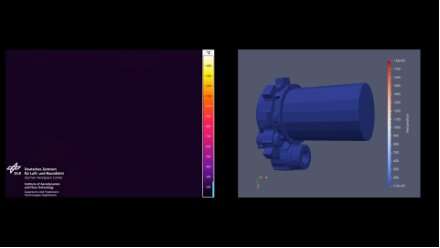Video: Simulating atmospheric reentry in a plasma wind tunnel

Simulating the burn-up during atmospheric reentry of one of the bulkiest items aboard a typical satellite using a plasma wind tunnel.
This Solar Array Drive Mechanism (SADM) has the essential task of keeping a satellite's solar wings trained on the Sun, maintaining mission operations.
But its bulky nature presents a problem in terms of space debris guidelines. When a spacecraft reenters on an uncontrolled basis, the spacecraft operator has to prove that the on-ground casualty risk posed by its satellite is lower than 1 in 10 000.
So last year SADM manufacturer Kongsberg Defense & Aerospace (KDA) started an investigation supported by ESA, Hyperschall Technologie Göttingen GmbH (HTG) and the German Aerospace Center (DLR) to demonstrate the 'desmisability' of one of its satellite products.
They began by modeling such a reentry using ESA's dedicated SCARAB (Spacecraft Atmospheric Reentry and Aerothermal Break-up) software and comparable resources, tweaking the SADM by switching one screw to lower-melting-point alumimium to promote an earlier, higher-altitude breakup.
Then their software model was compared to observed reality, by melting an actual SADM model inside DLR's LK3 plasma wind tunnel in Cologne. Arc-heated gas in the test chamber reaching speeds of several kilometers per second, reproducing reentry conditions.
Following assessment of the results, HTG went on to build a model of the SADM using ESA's DRAMA (Debris Risk Assessment and Mitigation Analysis) software tool, which will be available to other DRAMA users in the future.
As part of a larger effort called CleanSat, ESA is developing technologies and techniques to ensure future low-orbiting satellites are designed according to the concept of 'D4D' – Design for Demise.
More information: To read more detail about the test programme click here. To watch a full version of the plasma wind tunnel video, click here.
Provided by European Space Agency





















